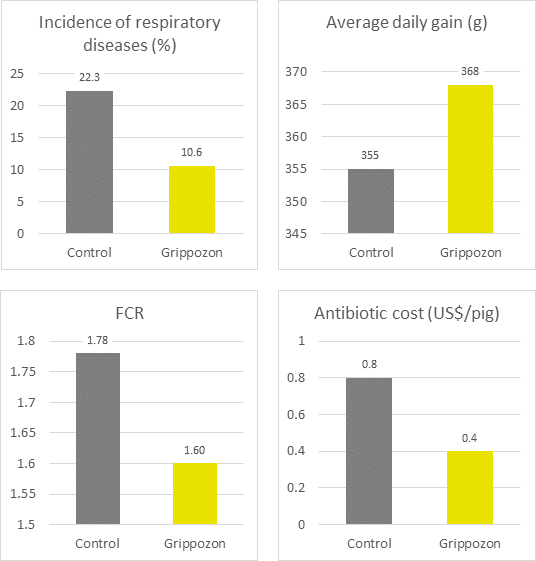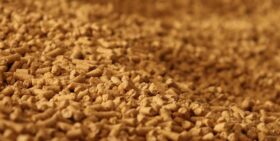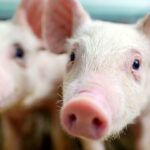By Dr. Inge Heinzl, Editor, EW Nutrition
Nowadays, intensive livestock farming with high stocking densities causes stress in the animals and affects the immune system9, 13. The increase in respiratory diseases with associated losses and costs is only one of the consequences. Due to antimicrobial resistance, antibiotics should only be used in critical cases, so effective alternatives are requested to support the animals.
Respiratory problems are a conjunction of several factors
It already has a name: PRDC or the Porcine Respiratory Disease Complex describes the cooperation of viruses, bacteria, and non-infectious factors such as environmental conditions (e.g., insufficient ventilation), stocking density, management (e.g., all-in-all-out only by pens and not for the whole house) and pig-specific factors such as age and genetics, altogether causing respiratory issues in pigs. Non-infectious factors such as high ammonia levels weaken the immune system and lay the foundation for, e.g., mycoplasmas which damage the ciliated epithelial cells in the upper respiratory tract, the first line of defense, and pave the way for PRRS viruses. They, on their part, enter the respiratory tract embedded in inhaled dust. There, they harm the macrophages and breach a further barrier of defense. Another pathfinder is the Porcine Circovirus 2 (PCV2), which destroys specific immune cells and leads to a generally higher susceptibility to infectious agents. Bacteria such as Pasteurella multocida or Streptococcus suis further on can cause secondary infections7, 20, 22. Also, the combination of mycoplasma hyopneumoniae and porcine circovirus, both typically low pathogenic organisms, leads to severe respiratory disease15.
Restricted respiratory function impacts growth
The main tasks of the respiratory tract are to take in oxygen from the air and to pump out the CO2 entailed by the catabolism of the tissue. In pigs, however, the respiratory tract is also responsible for thermoregulation, as pigs don’t have perspiration glands. The animals must get rid of excessive heat by rapid breathing. If the respiratory function is affected due to disease, thermoregulatory capacity is reduced. The resulting lower feed intake leads to decreased growth performance and less economic profit17. One of the first studies concerning this topic was conducted by Straw et al. (1989)21. They asserted that, with every 10 % more affected lung tissue, daily gain decreased by about 37g. This negative correlation between affected lung tissue and weight gain could be confirmed by Paz-Sánchez et al. (2021)18. They saw that animals with >10% lung parenchyma impacted by cranioventral bronchopneumonia needed a longer time to market (208.8 days vs. 200.8 days in the control), showed a lower carcass weight (74.1 kg vs. 77.7 kg in the control group) and, therefore, also a lower daily gain (500.8 g/day compared to 567.2 g/d). In another study, Pagot and co-workers (2007)16 observed 7000 pigs from 14 French farms. They saw a significant negative correlation (p<0.001) between the prevalence of pneumonia and growth and a weight gain loss of about 0.7 for each point of pneumonia increase.
Plant extracts support pigs with different modes of action
People have always used herbal substances to cure illnesses, be it willow bark for pain, chamomile for anti-inflammation or an upset stomach. Ribwort and thyme are used as cough suppressants, and eucalyptus and menthol help you breathe better. What is good for humans can also be used for pigs. To use plant extracts efficiently, it is crucial to know their specific modes of action. Due to their volatile nature, essential oils can directly reach the target site, the respiratory tract, via inhalation1.
1. Plant extracts can act as an antimicrobial
Many essential oils show some degree of antimicrobial activity. So, the oils of, e. g., oregano, tea tree, lemongrass, lemon myrtle, and clove are effective against a wide range of gram-positive and gram-negative bacteria. LeBel et al. (2019)12 tested nine different oils against microorganisms causing respiratory issues in pigs. They found the oils of cinnamon, thyme, and winter savory the most effective against Streptococcus suis, Actinobacillus pleuropneumoniae, Actinobacillus suis, Bordetella bronchiseptica, Haemophilus parasuis, and Pasteurella multocida, with MICs and MBCs from 0.01 to 0.156%.
Not only the direct bactericidal effect is important. 1,8 cineol, e.g., although often considered to have only marginal or no antimicrobial activity10, effectively causes leakage of bacterial membranes2 and allows other harmful substances to enter the bacterial cell. However, cineol possesses noted antiviral properties.
2. Plant extracts can have mucolytic, spasmolytic, and antitussive effects
In the case of respiratory disease, mucolytic and spasmolytic characteristics of phytomolecules are decisive in allowing efficient respiration. Mucolytic substances dissolve the mucus, make it more liquid and facilitate the removal from the respiratory tract by the ciliated epithelium. As liquifying the mucus with essential oils or phytomolecules is related to local irritation, dosage and application form are of the highest importance5.
The “cleanup” is called mucociliary clearance. There are also substances that do not dissolve the mucus but stimulate the mucociliary apparatus itself and increase mucociliary transport velocity1.
Spasmolytic activity on airway smooth muscle is shown, for example, by menthol8 or the essential oil of eucalyptus tereticornis4. Menthol showed antitussive effects11.
3. Plant extracts can have immune-modulatory and anti-inflammatory effects
If animals are suffering from a respiratory disease or are in danger of catching one, a supportive influence on the immune system is helpful. One thing is to make vaccination more effective. Mieres-Castro et al. (2021)14 figured out that the combined application of influenza vaccine and cineol to mice resulted in a longer survival time, less inflammation, less weight loss, a lower mortality rate, less pulmonary edema, and lower viral titers after a challenge with the virus seven days after the vaccination than the mice without cineol.
On the other hand, if the animals are already ill, strengthening their immune defense is essential. Li et al. (2012)13 showed that interleukin-6 concentration was lower (p<0.05) and the tumor necrosis factor-α level was higher (p<0.05) in the plasma of pigs fed a diet with 0.18% thymol and cinnamaldehyde than in the negative control group. Also, the lymphocyte proliferation for pigs fed the diet with thymol and cinnamaldehyde increased significantly compared with the negative control (p<0.05).
4. Plant extracts can act as an antioxidant
There are respiratory diseases in which reactive oxygen species (ROS) play an important role. In these cases, the antioxidant activity of phytomolecules is of interest. Here again, Li et al. (2012)13 asserted that a diet with 0.18% thymol and cinnamaldehyde increased the total antioxidant capacity level (p<0.05) in pigs compared to a negative control group.
Can Baser & Buchbauer (2010) described eucalyptus oil containing 1,8-cineole, the monoterpene hydrocarbons α-pinene (10–12%), p-cymene, and α-terpinene, and the monoterpene alcohol linalool, is used to treat diseases of the respiratory tract in which ROS play an important role.
5. Plant extracts reduce the production of ammonia
High concentration of ammonia in the pig house stresses the pigs’ respiratory tract and makes them susceptible to disease. Ammonia develops when feces and urine merge and the enzyme urease degrades them. Yucca extract, containing a high percentage of saponins, can reduce ammonia emissions in animal houses. Ehrlinger (2007)5 supposes that the glyco-components of the saponins bind ammonia and other harmful gases. Another explanation can be the decreased activity of urease shown in a trial with rats19 or the reduction of total nitrogen, urea nitrogen, and ammonia nitrogen in sow manure3.
6. Plant extracts often show diverse modes of useful action against respiratory issues
Due to their natural task – protecting the plant – essential oils typically do not show only one beneficial activity for us. Camphene, for example, in Thymus vulgaris, shows expectorant, spasmolytic, and antimicrobial properties and is used in treating respiratory tract infections. Menthol can be effectively used in cases of asthma due to its bronchodilatory activity on smooth muscle, its interaction with cold receptors, and the respiratory drive. Menthol acts antitussive in low concentration, gives the impression of decongestion and reduces respiratory discomfort and sensations of dyspnea.
Cineol, on its part, acts antimicrobial, antitussive, bronchodilatory, mucolytic, and anti-inflammatory. It promotes ciliary transport and improves lung function1, 6. Mucolytic, antioxidant, antiviral, and antibacterial activity is ascribed to thymol5.
Trial shows: phytomolecules help to keep respiratory diseases in check
A field study was conducted on a Philippine piglet farm with a history of chronic respiratory issues during the growing phase, with a morbidity of about 10-15%. In this study, a supplement for water containing phytomolecules that support animals against respiratory diseases (Grippozon) was tested. For the trial, 360 randomly selected 28-day-old pigs (average weight: 6.64±0.44 kg) were divided into two groups with 6 replications per group and 30 piglets per replication. All piglets came from sows raised antibiotic-free, and the piglets received antibiotics neither upon weaning except in case of symptoms (scouring: Baytril-1 mL/pig; respiratory disease: Excede – 1mL/pig). All piglets received the same feed and a regular water therapy regimen:
| Week 1 (1st week after weaning): |
|
| Week 2-10: |
|
Control group: no additional supplements
Grippozon group: Addition of 250 mL of Grippozon per 1000 L of water
As parameters, the incidence of respiratory disease, final weight, daily gain, FCR, and antibiotic cost, were recorded.

The phytomolecules-containing product reduced the incidence of respiratory diseases by 52 %, leading to a 53% lower cost for antibiotic treatment. The animals showed better growth performance (600 g higher average weight and 13 g higher average daily gain), altogether resulting in an extra cost-benefit of 1.76 US$ per pig.
Reduction in disease and medication ensures healthier pigs in the Grippozon-supplemented group, reflected by better performance.
We have means at hand to reduce the use of antibiotics
Respiratory disease is a big problem in pigs. Due to the still high occurrence of antimicrobial resistance, it is essential to reduce antibiotic use as much as possible. Phytomolecules offer the possibility to strengthen the animals’ health so that they are less susceptible to disease or support them when they are already infected. With the help of phytomolecules, we can reduce antibiotic treatments and help keep antibiotics effective when their use is indispensable.
References
- Can Baser , K. Hüsnü, and Gerhard Buchbauer. Handbook of Essential Oils: Science, Technology, and Applications. Boca Raton, FL: Taylor & Francis distributor, 2010.
- Carson, Christine F., Brian J. Mee, and Thomas V. Riley. “Mechanism of Action of Melaleuca Alternifolia (Tea Tree) Oil on Staphylococcus Aureus Determined by Time-Kill, Lysis, Leakage, and Salt Tolerance Assays and Electron Microscopy.” Antimicrobial Agents and Chemotherapy 46, no. 6 (2002): 1914–20. https://doi.org/10.1128/aac.46.6.1914-1920.2002.
- Chen, Fang, Yantao Lv, Pengwei Zhu, Chang Cui, Caichi Wu, Jun Chen, Shihai Zhang, and Wutai Guan. “Dietary Yucca Schidigera Extract Supplementation during Late Gestating and Lactating Sows Improves Animal Performance, Nutrient Digestibility, and Manure Ammonia Emission.” Frontiers in Veterinary Science 8 (2021). https://doi.org/10.3389/fvets.2021.676324.
- Coelho-de-Souza, Lívia Noronha, José Henrique Leal-Cardoso, Francisco José de Abreu Matos, Saad Lahlou, and Pedro Jorge Magalhães. “Relaxant Effects of the Essential Oil of Eucalyptus Tereticornisand Its Main Constituent 1,8-Cineole on Guinea-Pig Tracheal Smooth Muscle.” Planta Medica 71, no. 12 (2005): 1173–75. https://doi.org/10.1055/s-2005-873173.
- Ehrlinger, Miriam. “Phytogene Zusatzstoffe in der Tierernährung.” Dissertation, Tierärztliche Fakultät LMU, 2007.
- Gelbe Liste Online. “Gelbe Liste Pharmindex Online.” Gelbe Liste. Accessed January 20, 2023. https://www.gelbe-liste.de/.
- Hennig-Pauka, Isabell. “Atemwegserkrankungen: Schutz fängt schon bei Ferkeln an.” Der Hoftierarzt, January 13, 2021. https://derhoftierarzt.de/2021/01/atemwegserkrankungen-schutz-faengt-schon-bei-ferkeln-an/.
- Ito, Satoru, Hiroaki Kume, Akira Shiraki, Masashi Kondo, Yasushi Makino, Kaichiro Kamiya, and Yoshinori Hasegawa. “Inhibition by the Cold Receptor Agonists Menthol and ICILIN of Airway Smooth Muscle Contraction.” Pulmonary Pharmacology & Therapeutics 21, no. 5 (2008): 812–17. https://doi.org/10.1016/j.pupt.2008.07.001.
- Kim, K.H., E.S. Cho, K.S. Kim, J.E. Kim, K.H. Seol, S.J. Sa, Y.M. Kim, and Y.H. Kim. “Effects of Stocking Density on Growth Performance, Carcass Grade and Immunity of Pigs Housed in Sawdust Fermentative Pigsties.” South African Journal of Animal Science 46, no. 3 (2016): 294–301. https://doi.org/10.4314/sajas.v46i3.9.
- Kotan, Recep, Saban Kordali, and Ahmet Cakir. “Screening of Antibacterial Activities of Twenty-One Oxygenated Monoterpenes.” Zeitschrift für Naturforschung C 62, no. 7-8 (2007): 507–13. https://doi.org/10.1515/znc-2007-7-808.
- Laude, E.A., A.H. Morice, and T.J. Grattan. “The Antitussive Effects of Menthol, Camphor, and Cineole in Conscious Guinea-Pigs.” Pulmonary Pharmacology 7, no. 3 (1994): 179–84. https://doi.org/10.1006/pulp.1994.1021.
- LeBel, Geneviève, Katy Vaillancourt, Philippe Bercier, and Daniel Grenier. “Antibacterial Activity against Porcine Respiratory Bacterial Pathogens and in Vitro Biocompatibility of Essential Oils.” Archives of Microbiology 201, no. 6 (2019): 833–40. https://doi.org/10.1007/s00203-019-01655-7.
- Li, Xue, Xia Xiong, Xin Wu, Gang Liu, Kai Zhou, and Yulong Yin. “Effects of Stocking Density on Growth Performance, Blood Parameters and Immunity of Growing Pigs.” Animal Nutrition 6, no. 4 (2020): 529–34. https://doi.org/10.1016/j.aninu.2020.04.001.
- Mieres-Castro, Daniel, Sunny Ahmar, Rubab Shabbir, and Freddy Mora-Poblete. “Antiviral Activities of Eucalyptus Essential Oils: Their Effectiveness as Therapeutic Targets against Human Viruses.” Pharmaceuticals 14, no. 12 (2021): 1210. https://doi.org/10.3390/ph14121210.
- Opriessnig, T., L. G. Giménez-Lirola, and P. G. Halbur. “Polymicrobial Respiratory Disease in Pigs.” Animal Health Research Reviews 12, no. 2 (2011): 133–48. https://doi.org/10.1017/s1466252311000120.
- Pagot, E., P. Keita, and A. Pommier. “Relationship between Growth during the Fattening Period and Lung Lesions at Slaughter in Swine.” Revue Méd. Vét., , , 5, 253-259 158, no. 5 (2007): 253–59.
- Pallarés Martínez, Francisco José, Jaime Gómez Laguna, Inés Ruedas Torres, José María Sánchez Carvajal, Fernanda Isabel Larenas Muñoz, Irene Magdalena Rodríguez-Gómez, and Librado Carrasco Otero. “The Economic Impact of Pneumonia Processes in Pigs.” https://www.pig333.com. Pig333.com Professional Pig Community, December 14, 2020. https://www.pig333.com/articles/the-economic-impact-of-pneumonia-processes-in-pigs_16470/.
- Paz-Sánchez, Yania, Pedro Herráez, Óscar Quesada-Canales, Carlos G. Poveda, Josué Díaz-Delgado, María del Quintana-Montesdeoca, Elena Plamenova Stefanova, and Marisa Andrada. “Assessment of Lung Disease in Finishing Pigs at Slaughter: Pulmonary Lesions and Implications on Productivity Parameters.” Animals 11, no. 12 (2021): 3604. https://doi.org/10.3390/ani11123604.
- Preston, R. L., S. J. Bartle, T. May, and S. R. Goodall. “Influence of Sarsaponin on Growth, Feed and Nitrogen Utilization in Growing Male Rats Fed Diets with Added Urea or Protein.” Journal of Animal Science 65, no. 2 (1987): 481–87. https://doi.org/10.2527/jas1987.652481x.
- Ruggeri, Jessica, Cristian Salogni, Stefano Giovannini, Nicoletta Vitale, Maria Beatrice Boniotti, Attilio Corradi, Paolo Pozzi, Paolo Pasquali, and Giovanni Loris Alborali. “Association between Infectious Agents and Lesions in Post-Weaned Piglets and Fattening Heavy Pigs with Porcine Respiratory Disease Complex (PRDC).” Frontiers in Veterinary Science 7 (2020). https://doi.org/10.3389/fvets.2020.00636.
- Straw , B. E., V. K. Tuovinen, and M. Bigras-Poulin. “Estimation of the Cost of Pneumonia in Swine Herds.” J Am Vet Med Assoc. 1989 Dec 15;195(12):1702-6. 195, no. 12 (December 15, 1989): 1702–6.
- White, Mark. “Porcine Respiratory Disease Complex (PRDC).” Livestock 16, no. 2 (2011): 40–42. https://doi.org/10.1111/j.2044-3870.2010.00025.x.
















